Book
ISBN: 9780754664079 9780754693291 0754664074 9781315590387 9781317111177 9781317111184 0754693295 Year: 2009 Publisher: Aldershot Ashgate
Abstract | Keywords | Export | Availability | Bookmark
 Loading...
Loading...Choose an application
- Reference Manager
- EndNote
- RefWorks (Direct export to RefWorks)
Jerome of Stridon (c.346-420) is arguably the greatest polymath in Latin Christian antiquity; this is the most comprehensive and up to date volume on his life and work available in English today. Familiar debates are re-opened, hitherto uncharted terrain is explored, and problems old and new are posed and solved with the use of innovative methodologies. This is an indispensable resource not only for specialists on Jerome but also for students and scholars who cultivate interests broadly in the history, religion, society, and literature of the late antique Christian world.
Christian saints --- Saints chrétiens --- Congresses --- Congrès --- Jerome, --- 276 =75 HIERONYMUS --- Griekse patrologie--HIERONYMUS --- Gerolamo, --- Gérome, --- Gerónimo, --- Girolamo, --- Heronimos, --- Hieronim, --- Hieronymus, Eusebius, --- Hieronymus, --- Hieronymus, Sophronius Eusebius, --- Hieronymus, Stridonensis, --- Ieronim, Stridonskiĭ, --- Iheronimus, --- Jerónimo, --- Jerōnimos, --- Conferences - Meetings --- Jerome. --- Christianity --- Religion --- Philosophy & Religion --- Saints chrétiens --- Congrès --- Jeronimi, --- Hieronymus presb. --- Jerome, - Saint, - -419 or 420
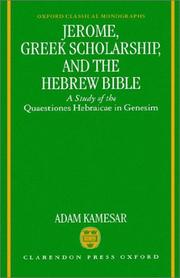
ISBN: 0198147279 9780198147275 Year: 1993 Publisher: Oxford Clarendon
Abstract | Keywords | Export | Availability | Bookmark
 Loading...
Loading...Choose an application
- Reference Manager
- EndNote
- RefWorks (Direct export to RefWorks)
Greek philology. --- 276 =71 HIERONYMUS, SOPHRONIUS EUSEBIUS --- Greek philology --- Classical philology --- Greek language --- Greek literature --- Latijnse patrologie--HIERONYMUS, SOPHRONIUS EUSEBIUS --- Jerome Saint --- -Knowledge --- -Greek philology --- Jerome, --- Gerolamo, --- Gérome, --- Gerónimo, --- Girolamo, --- Heronimos, --- Hieronim, --- Hieronymus, Eusebius, --- Hieronymus, --- Hieronymus, Sophronius Eusebius, --- Hieronymus, Stridonensis, --- Ieronim, Stridonskiĭ, --- Iheronimus, --- Jerónimo, --- Jerōnimos, --- Knowledge --- Bible. --- Versions --- Vulgate. --- Jeronimi,
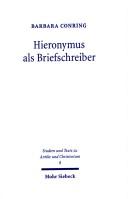
ISBN: 316147502X Year: 2001 Publisher: Tübingen Mohr Siebeck
Abstract | Keywords | Export | Availability | Bookmark
 Loading...
Loading...Choose an application
- Reference Manager
- EndNote
- RefWorks (Direct export to RefWorks)
276 =71 HIERONYMUS, SOPHRONIUS EUSEBIUS --- Letter writing, Classical --- #GOSA:II.P.HI.M --- Classical letter writing --- Latijnse patrologie--HIERONYMUS, SOPHRONIUS EUSEBIUS --- Jerome Saint --- -Literary style --- Letter writing, Classical. --- Jerome, --- Literary style. --- Gerolamo, --- Gérome, --- Gerónimo, --- Girolamo, --- Heronimos, --- Hieronim, --- Hieronymus, Eusebius, --- Hieronymus, --- Hieronymus, Sophronius Eusebius, --- Hieronymus, Stridonensis, --- Ieronim, Stridonskiĭ, --- Iheronimus, --- Jerónimo, --- Jerōnimos, --- Jeronimi,
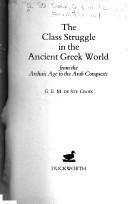
ISBN: 0715607383 9780715607381 Year: 1975 Publisher: London Duckworth
Abstract | Keywords | Export | Availability | Bookmark
 Loading...
Loading...Choose an application
- Reference Manager
- EndNote
- RefWorks (Direct export to RefWorks)
#GOSA:II.P.HI.M --- #GROL:SEMI-276-05 Hier --- 235.3 HIERONYMUS --- 871 HIERONYMUS --- 871 HIERONYMUS Latijnse literatuur--HIERONYMUS --- Latijnse literatuur--HIERONYMUS --- Hagiografie--HIERONYMUS --- Jerome, --- Gerolamo, --- Gérome, --- Gerónimo, --- Girolamo, --- Heronimos, --- Hieronim, --- Hieronymus, Eusebius, --- Hieronymus, --- Hieronymus, Sophronius Eusebius, --- Hieronymus, Stridonensis, --- Ieronim, Stridonskiĭ, --- Iheronimus, --- Jerónimo, --- Jerōnimos, --- Jeronimi, --- Jerome, - Saint, - -419 or 420 --- Hieronymus presb.
Book
ISBN: 352717589X Year: 1988 Publisher: Weinheim VCH
Abstract | Keywords | Export | Availability | Bookmark
 Loading...
Loading...Choose an application
- Reference Manager
- EndNote
- RefWorks (Direct export to RefWorks)
Art, Italian --- Art, Renaissance --- Asceticism in art --- Christian saints in art --- Renaissance art --- Themes, motives --- Jerome, --- Gerolamo, --- Gérome, --- Gerónimo, --- Girolamo, --- Heronimos, --- Hieronim, --- Hieronymus, Eusebius, --- Hieronymus, --- Hieronymus, Sophronius Eusebius, --- Hieronymus, Stridonensis, --- Ieronim, Stridonskiĭ, --- Iheronimus, --- Jerónimo, --- Jerōnimos, --- Art. --- Iconography --- History of civilization --- skulls [skeleton components] --- asceticism --- Renaissance --- scholars --- Jerome --- anno 1300-1399 --- anno 1400-1499 --- anno 1500-1599 --- Italy --- Jeronimi,
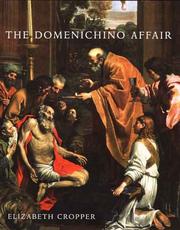
ISBN: 0300109148 Year: 2005 Publisher: New Haven, Conn. Yale University Press
Abstract | Keywords | Export | Availability | Bookmark
 Loading...
Loading...Choose an application
- Reference Manager
- EndNote
- RefWorks (Direct export to RefWorks)
Ten years after completing his work 'The Last Communion of Saint Jerome, 'Bolognese painter Domenichino was accused by his rival Giovanni Lanfranco of stealing the idea for the painting from an altarpiece crafted by Lanfranco's teacher, Agostino Carracci. The resulting scandal reverberated through the centuries, drawing responses by artists and critics from Poussin and Malvasia to Fuseli and Delacroix. Why was Domenichino attacked in this way when other related paintings& including Raphael's 'Marriage of the Virgin 'and Perugino's painting of the same subject& aroused no such negative response? In this fast-paced book, Elizabeth Cropper investigates the Domenichino affair and addresses the perennial debate regarding the precise nature of originality and of imitation. She offers close readings of the paintings involved in the story, detailed analysis of attitudes toward imitation, emulation, and plagiarism, and a fascinating discussion of what Domenichino's plight signifies in art history.
Painting --- Aesthetics of art --- Domenichino --- Jerome --- Carracci, Agostino --- Rome --- Imitatie in de kunst --- Imitation dans l'art --- Imitation in art --- Imitation in art. --- Painting, Renaissance --- Domenichino, --- Carracci, Agostino, --- Jerome, --- Authorship. --- Art --- Pictures --- Appropriation (Art) --- Mimesis in art --- Reproduction --- Copying --- Carrache, Augustin, --- Caracci, Agostino, --- Gerolamo, --- Gérome, --- Gerónimo, --- Girolamo, --- Heronimos, --- Hieronim, --- Hieronymus, Eusebius, --- Hieronymus, --- Hieronymus, Sophronius Eusebius, --- Hieronymus, Stridonensis, --- Ieronim, Stridonskiĭ, --- Iheronimus, --- Jerónimo, --- Jerōnimos, --- Domenico, Zampieri --- Authorship --- Painting [Renaissance ] --- Italy --- Jeronimi,
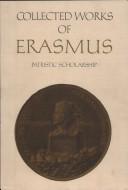
ISBN: 0802027601 9780802027603 9786612011573 128201157X 1442678305 Year: 1992 Volume: 61 Publisher: Toronto University Press
Abstract | Keywords | Export | Availability | Bookmark
 Loading...
Loading...Choose an application
- Reference Manager
- EndNote
- RefWorks (Direct export to RefWorks)
Of all the church Fathers, Erasmus preferred St Jerome, for in him he found the perfect combination of 'bonae litterae' and 'philosophia Christi,' which were to become the two fundamental concepts of the Erasmian reform program. This volume is devoted to Erasmus' edition of the works of St. Jerome, including his letters and a variety of other writings, and, most important, Erasmus' Life of Jerome. As a work of patristic scholarship, this first critical biography of the saint was a major achievement, distinguished for its historical portrait of Jerome with all his faults and virtues, and free of the myths, legends, and stories that grew up around him in the Middle Ages.Originally published in 1516, the edition of the works of St Jerome consisted of nine folio volumes, the first four of which were Erasmus' chief responsibility. This selection from the edition, translated and annotated by James F. Brady and John C. Olin, is the first presentation of this outstanding work since the sixteenth century and makes available parts that are both important in themselves and representative of Erasmus' contribution. Extenstive introductions and notes by the editors provide full information about the texts.
Jerome --- Fathers of the church. --- Fathers of the church --- Church fathers --- Patristics --- Philosophy, Patristic --- Christians --- Jerome Saint --- Jerome, --- Gerolamo, --- Gérome, --- Gerónimo, --- Girolamo, --- Heronimos, --- Hieronim, --- Hieronymus, Eusebius, --- Hieronymus, --- Hieronymus, Sophronius Eusebius, --- Hieronymus, Stridonensis, --- Ieronim, Stridonskiĭ, --- Iheronimus, --- Jeronimi, --- Jerónimo, --- Jerōnimos, --- 873.4 ERASMUS ROTERODAMUS, DESIDERIUS --- 873.4 ERASMUS ROTERODAMUS, DESIDERIUS Humanistisch Latijnse literatuur--ERASMUS ROTERODAMUS, DESIDERIUS --- Humanistisch Latijnse literatuur--ERASMUS ROTERODAMUS, DESIDERIUS --- Érasme,
Book
ISBN: 9780199672608 0199672601 Year: 2013 Volume: *9 Publisher: Oxford Oxford University Press
Abstract | Keywords | Export | Availability | Bookmark
 Loading...
Loading...Choose an application
- Reference Manager
- EndNote
- RefWorks (Direct export to RefWorks)
Jerome's Epitaph on Saint Paula (Epitaphium Sanctae Paulae) is one of the most famous writings by one of the most prolific authors in all of Latin antiquity. Composed in 404, it is an elaborate eulogy commemorating the life of Paula (347-404), a wealthy Christian widow from Rome who renounced her senatorial status and embraced a lifestyle of ascetic self-discipline and voluntary poverty. She used her vast inherited fortune to fund various charitable causes and to co-found with Jerome, in 386, a monastic complex in Bethlehem which was equipped with a hostelry for Christian pilgrims. The Epitaphium is one of the core primary texts on female spirituality (both real and idealized) in Late Antiquity, and it also is one of Jerome's crowning literary achievements, yet until now it has not received the depth of scholarly analysis that only a proper commentary can afford. This book presents the first full-scale commentary on this monumental work in any language. Cain accesses a very extensive array of ancient sources to fully contextualize the Epitaphium and he comprehensively addresses stylistic, literary, historical, topographical, theological, text-critical and other issues of interpretive interest, including relevant matters of Hebrew, Greek, and Latin philology. Considerable effort also is expended on extricating the elusive Paula of history from the sticky web of Jerome's idealized hagiographic construct of her. Accompanying the commentary is an introduction which situates the Epitaphium in the broader context of its author's life and work and exposes its various propagandistic dimensions. The critical Latin text and the facing-page translation will make the Epitaphium more accessible than ever before and will provide a reliable textual apparatus for future scholarship on this key Hieronymian writing.
Jerome, --- Paula, --- Criticism and interpretation --- Hieronymus, Sophronius Eusebius, --- Criticism and interpretation. --- 276 =71 HIERONYMUS, SOPHRONIUS EUSEBIUS --- Latijnse patrologie--HIERONYMUS, SOPHRONIUS EUSEBIUS --- Paola, --- Paule, --- Gerolamo, --- Gérome, --- Gerónimo, --- Girolamo, --- Heronimos, --- Hieronim, --- Hieronymus, Eusebius, --- Hieronymus, --- Hieronymus, Stridonensis, --- Ieronim, Stridonskiĭ, --- Iheronimus, --- Jerónimo, --- Jerōnimos, --- Jeronimi, --- Paula vidua Romana --- Jerome, - Saint, - -419 or 420. - Epitaphium Sanctae Paulae --- Jerome, - Saint, - -419 or 420 - Criticism and interpretation --- Paula, - Saint, - 347-404 --- Jerome, - Saint, - -419 or 420
Book
ISBN: 3774925925 9783774925922 Year: 1993 Volume: 36 Publisher: Bonn Habelt
Abstract | Keywords | Export | Availability | Bookmark
 Loading...
Loading...Choose an application
- Reference Manager
- EndNote
- RefWorks (Direct export to RefWorks)
Women in Christianity --- History --- Jerome, --- Views on women. --- -Christianity --- -Jerome Saint --- -Views on women --- -History --- Gerolamo, --- Gérome, --- Gerónimo, --- Girolamo, --- Heronimos, --- Hieronim, --- Hieronymus, Eusebius, --- Hieronymus, --- Hieronymus, Sophronius Eusebius, --- Hieronymus, Stridonensis, --- Ieronim, Stridonskiĭ, --- Iheronimus, --- Jerónimo, --- Jerōnimos, --- Views on women --- Jeronimi, --- Women in Christianity - History - Early church, ca. 30-600. --- Hieronymus presb. --- Jerome, - Saint, - -419 or 420 - Views on women --- Jerome, - Saint, - -419 or 420

ISBN: 0801823811 0801823811 0801837472 9780801837470 9780801823817 Year: 1985 Volume: 13th Publisher: Baltimore, Md Johns Hopkins University Press
Abstract | Keywords | Export | Availability | Bookmark
 Loading...
Loading...Choose an application
- Reference Manager
- EndNote
- RefWorks (Direct export to RefWorks)
Jerome, Saint, d. 419 or 20 --- Renaissance. --- Renaissance --- Influence. --- Jerome, --- Jerome --- Jerome Saint --- Influence --- Revival of letters --- History --- Gerolamo, --- Gérome, --- Gerónimo, --- Girolamo, --- Heronimos, --- Hieronim, --- Hieronymus, Eusebius, --- Hieronymus, --- Hieronymus, Sophronius Eusebius, --- Hieronymus, Stridonensis, --- Ieronim, Stridonskiĭ, --- Iheronimus, --- Jerónimo, --- Jerōnimos, --- Civilization --- History, Modern --- Civilization, Medieval --- Civilization, Modern --- Humanism --- Middle Ages --- Jeronimi, --- Jerome, - Saint, - -419 or 420 - Influence --- Civilisation de la renaissance --- Jerome, - Saint, - -419 or 420

 Search
Search Feedback
Feedback About UniCat
About UniCat  Help
Help News
News